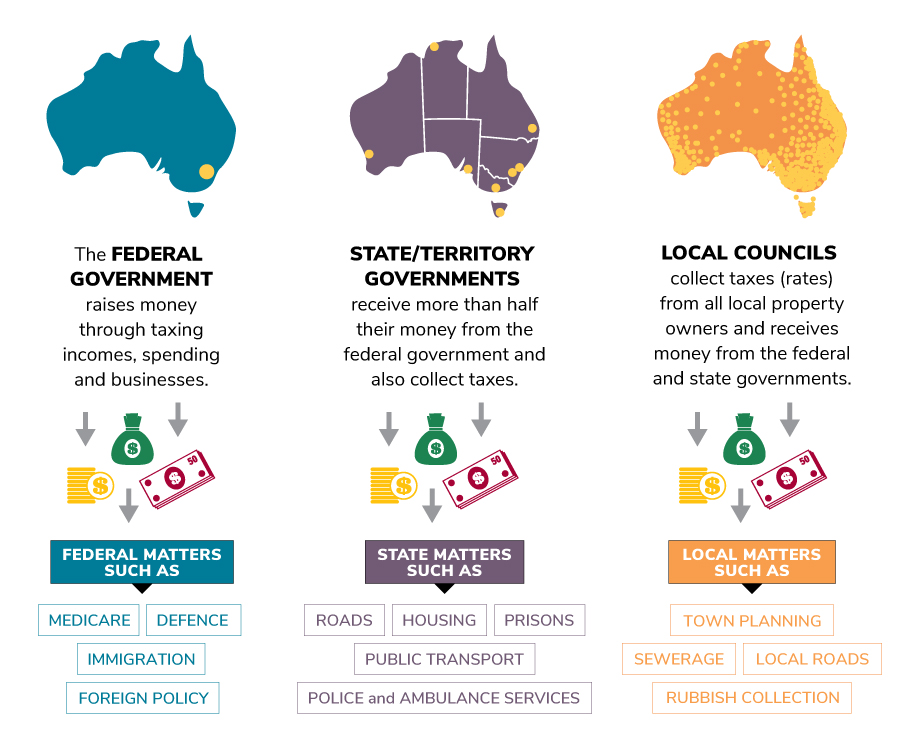The responsibilities of the three levels of government
This fact sheet introduces the three levels of government in Australia and lists some of the responsibilities of each level.
What will I learn?
- Australia’s three levels of government are the federal government, state and territory governments, and local councils.
- Each level of government has responsibility for providing different services to Australians.
Curriculum alignment
Year 4 ACHASSK091
Year 6 ACHASSK144
Year 7 ACHCK048
What are the three levels of government?
Australia has three levels of government that work together to help provide us with the services we need. How the federal and state parliaments work together is sometimes referred to as the division of powers.
The three levels are:
- federal – Australian – Parliament, in Canberra
- state and territory parliaments or legislative assemblies, in each state and territory capital city
- local councils – also called shires or municipalities – across Australia.
The 6 state and 2 territory parliaments are:
- ACT Legislative Assembly
- Legislative Assembly of the Northern Territory
- Parliament of New South Wales
- Parliament of South Australia
- Parliament of Tasmania
- Parliament of Victoria
- Parliament of Western Australia
- Queensland Parliament.
There are over 550 local councils around Australia.
Responsibilities
Representatives are elected to the federal Parliament, the state and territory parliaments, and to local councils, so that all Australians have someone to represent them at each level of government.
Each level is responsible for providing different services to Australians. Sometimes these responsibilities overlap.
FEDERAL GOVERNMENT |
STATE AND TERRITORY GOVERNMENTS |
LOCAL COUNCILS |
|
Responsible for issues that affect all Australians (national issues) |
Responsible for issues that affect people in that state or territory |
Responsible for issues that affect local communities |
|
Post, telephones and the internet Money Immigration Defence |
Public transport Schools Hospitals Policing |
Rubbish collection and recycling Parks, sports fields and swimming pools Pet control Parking |
All levels of governments raise money through the collection of taxes, fees, and other charges to pay for the services they provide to Australians. Local councils also receive funding from the federal and state levels of government.
How governments in Australia raise and spend money.

Parliamentary Education Office (peo.gov.au)
Description
This diagram shows how governments raise and spend money.
The federal government raises money through taxing incomes, spending and businesses. The money is spent on federal matters such as: Medicare, defence, immigration, foreign policy.
State/territory governments receive more than half their money from the federal government and also collect taxes. The money is spent on state matters such as: roads, prisons, housing, public transport, police and ambulance services.
Local councils collect taxes (rates) from all local property owners and receives money from the federal and state governments. The money is spent on local matters such as: town planning, rubbish collection, water and sewage, dog registration and local roads.
Copyright information
This work is licensed under a Creative Commons Attribution-NonCommercial-NoDerivs 3.0 Unported License.
You are free to share – to copy, distribute and transmit the work.
Attribution – you must attribute the work in the manner specified by the author or licensor (but not in any way that suggests that they endorse you or your use of the work).
Non-commercial – you may not use this work for commercial purposes.
No derivative works – you may not alter, transform, or build upon this work.
Waiver – any of the above conditions can be waived if you get permission from the copyright holder.
The Australian Constitution
Sections 51 and 52 of the Australian Constitution list the areas which the federal Parliament can make laws about. For other areas, the federal and state levels have shared responsibilities – concurrent powers. These areas include education, health and water management.
Section 109 says that if a state parliament and federal Parliament pass conflicting laws on the same subject, then the federal law overrides the state law. Section 122 allows the federal Parliament to override a territory law at any time.
The states and territories can make laws to create local councils. The Australian Capital Territory (ACT) does not have local councils. The ACT Legislative Assembly is responsible for both state and local government responsibilities.
